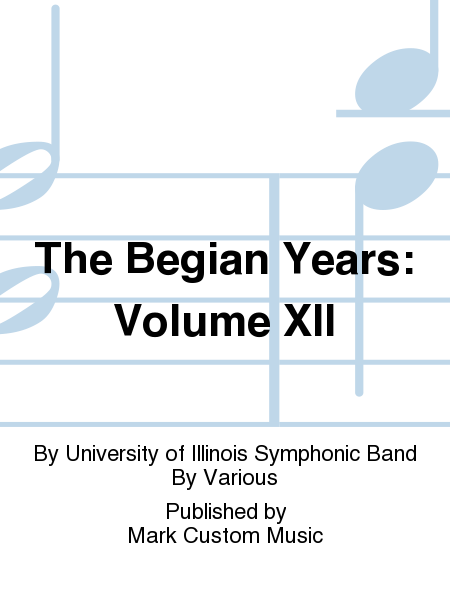The Begian Years: Volume XII
-
Ships in 4 to 6 weeks
Details
Description
SKU: MK.3084-MCD
By University of Illinois Symphonic Band. By Various. Mark Records. Classical. Audio CD. Published by Mark Custom Music (MK.3084-MCD).UPC: 710396308429. Conductor: Dr. Harry Begian.
The notes with this outstanding recording paint a vivid picture of the first performance of Hector Berlioz's Symphonie Funebre et Triomphale. The year was 1840, and the work was commissioned by the French government for a grand ceremony in honor of the 10th Anniversary of the July Revolution. The event began with the performance of a Cherubini requiem mass. Then a long procession wound its way through Paris as 50 black-draped coffins were moved from a cemetery to a new monument at the Place de la Bastille. The parade was led by a 207-man marching band--Berlioz conducting with his sword--which played his long-winded and dour Marche funebre six times (that would take two hours). The reinterment ceremony was marked by an Oraison funebre, a somber trombone solo. Finally, the heroes were saluted with a rousing Apotheose. The work was met with such enthusiasm that it was performed many times in Berlioz s lifetime. In 1842 he added string and choral parts to the finale, and the Marche funebre was played at his funeral. Given its popularity in 19th-Century France, you might wonder why the work is not played often in 20th-Century America. Well, first there's that bloated, which--until now--has never been anything but a tedious listening experience for me. Then there's II, which in the original key is a fairly taxing solo for a trombonist. Those factors are enough to make modern band directors look elsewhere. Most bands make the March funebre sound dreary and too long, and I had concluded long ago that it is not a good piece of music. But John Bourgeois and the US Marine Band give the long, lyrical melodic lines a sense of determined, sustained intensity that make them sound grim and inexorable. Remarkably detailed sonics help, too--the bass drum is a clear and ominous presence, for instance. For me it is like hearing a whole new piece. I wish the same were true of the Oraison funebre. Trombonist Philip Franke's distance from the microphone might well resemble the sound of a concert performance, but it severely reduces the impact of his dramatic lines. The Apotheose that follows is terrific, though, especially when the University of Maryland Chorus joins in near the end. I had not heard this choral component before, and it is a wonderful addition. Also included is the Francs-Juges Overture, written at age 23 in 1826. Berlioz once heard the work performed by a band--a gigantic 320-man one at the palace of the Crown Prince of Prussia--so this arrangement by Thomas Knox is by no means the first. While every instrumental section plays an important role in this exciting work, the trombones have some great moments of bombasty, and the clarinets are superb in many unison and virtuoso passages. The notes don t say when these works were recorded, but Bourgeois led the Marine Band from 1979 through 1996.--American Record Guide September/October 2001.
About Listening CDs
Listening CDs are traditional music recordings. Listening CDs make a great educational supplement - hear exceptional professionals play the music you're learning! Or, just enjoy listening to the music you love.
Song List (5)
- Symphony #1
- Concerto in D
- Slavonic Dances
- Symphonic Variants for Euphonium
- Dionysiaques

 Share
Share